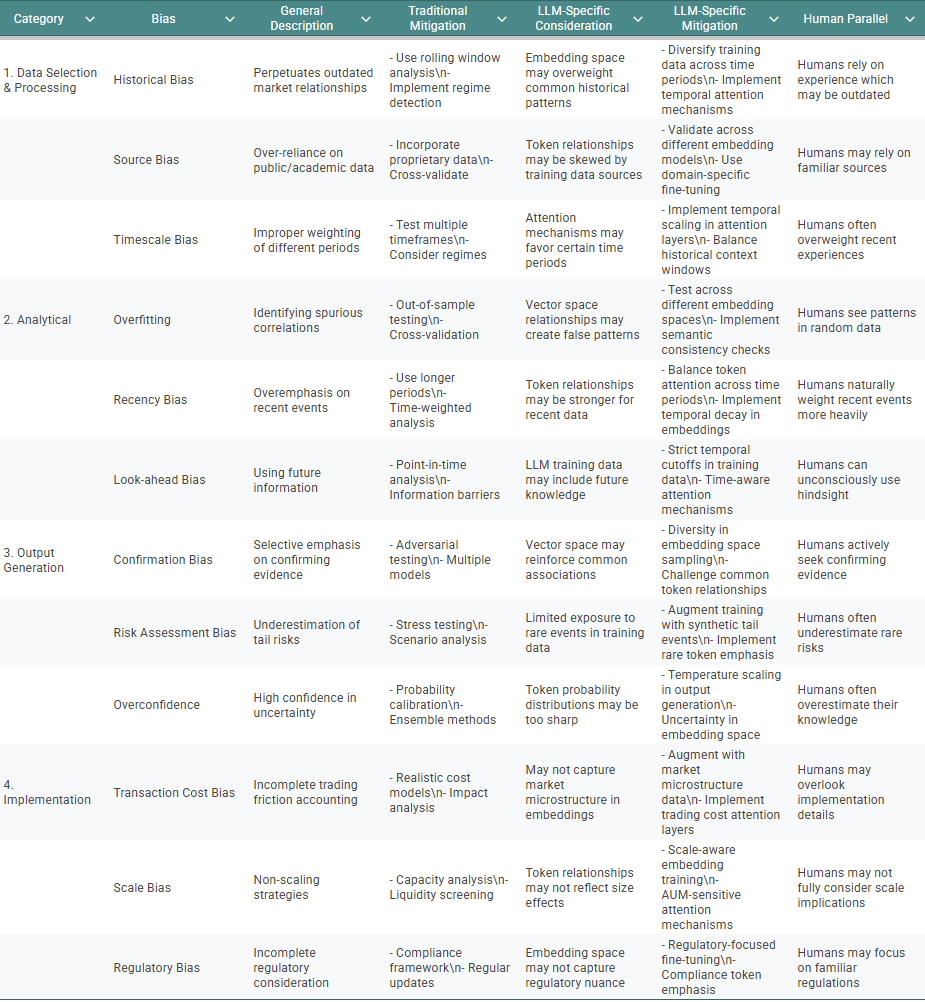Understanding LLM Biases in Quantitative Research
From Lunch Conversation to Framework
Yesterday's lunch conversation with an LLM Expert Engineer sparked a fascinating exploration into the parallels between human cognitive biases and those exhibited by Large Language Models (LLMs) in quantitative research. What began as a technical discussion about how LLMs process information through sharding and vectorization evolved into a deeper investigation of bias in artificial intelligence.
The Genesis
During our lunch discussion, the engineer explained how LLMs break down information into vectors - essentially creating a multi-dimensional space where related concepts cluster together. This process, while powerful, inherently creates potential for systematic biases. Just as human brains create mental shortcuts and associations that can lead to cognitive biases, LLMs develop their own patterns of association through their vector spaces.
This morning, Andre Profitt posed what seemed like a simple question on social media: "What biases did you find in the models?" This prompted me to engage in an extensive analysis with Claude, exploring the various ways biases manifest in quantitative investment research when using LLMs.
The Revelation
What emerged was a striking realization: while LLMs and humans often exhibit similar biases, the underlying mechanisms are fundamentally different. For instance, where humans might develop confirmation bias through emotional investment in their ideas, LLMs can display similar behavior through the reinforcement of patterns in their training data and vector space relationships.
This led to several key insights:
Vector Space Dynamics: The way LLMs shard and vectorize information can create systematic biases in how they process and relate financial concepts.
Pattern Recognition Differences: Unlike human intuitive pattern recognition, LLMs rely on statistical relationships in their vector spaces, which can lead to different types of analytical biases.
Complementary Strengths: Understanding these differences opens opportunities to leverage the complementary strengths of human and machine intelligence in quantitative research.
A Framework Emerges
Through this exploration, it became clear that we needed a comprehensive framework to understand and address these biases. Working with Claude, we developed a detailed analysis that maps out traditional biases, their LLM-specific manifestations, and corresponding mitigation strategies.
The framework we developed goes beyond simple bias identification, incorporating:
Parallel analysis of human and LLM biases
Specific considerations for LLM vector space relationships
Practical mitigation strategies for both traditional and LLM-specific biases
Implementation guidelines for real-world applications
Special Considerations for Pattern Recognition
Statistical vs. Intuitive:
LLMs: Pattern recognition through vector space statistics
Humans: Pattern recognition through experience and intuition
Integration: Combine statistical rigor with human intuition
Memory Processing:
LLMs: Attention mechanisms across token relationships
Humans: Associative memory with creative connections
Integration: Use LLMs for broad pattern identification, humans for novel insights
Bias Awareness:
LLMs: Require explicit programming for bias detection
Humans: Can consciously recognize and adjust for biases
Integration: Implement systematic checks with human oversight
Implementation Guidelines
Regular Review Process:
Monitor both traditional and LLM-specific biases
Update mitigation strategies as LLM technology evolves
Document bias incidents and successful mitigations
Cross-Validation Framework:
Compare LLM outputs with traditional methods
Validate across different LLM architectures
Incorporate human expert review
Continuous Improvement:
Regular retraining with updated data
Refinement of bias detection methods
Evolution of mitigation strategies
What makes this framework particularly valuable is its recognition that effective bias mitigation in quantitative research requires understanding both the similarities and differences between human and LLM biases. It's not enough to simply apply traditional bias mitigation strategies to LLMs - we need to understand and address the unique ways these biases manifest in artificial intelligence.
Looking Forward
As we continue to integrate LLMs into quantitative research processes, understanding these biases becomes increasingly critical. This framework serves as a starting point for developing more robust and reliable research methodologies that leverage the strengths of both human and artificial intelligence while mitigating their respective weaknesses.



Already implemented some of your framework suggestions into my investment risk modelling. Look forward to more collaboration!